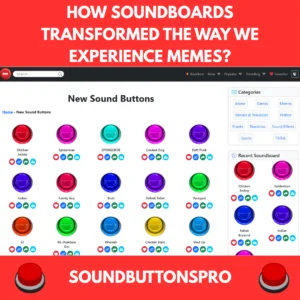Memes used to be silent. We laughed at still images – a captioned cat, a confused SpongeBob, a crying Michael Jordan. Then came short videos, reaction GIFs, and finally, a revolution we didn’t see coming: sound. Today, the internet doesn’t just scroll through memes – it hears them. The rise of soundboards has turned viral humor into an immersive, multi-sensory experience that blends sound, emotion, and timing into something unmistakably modern. Platforms like SoundButtonsPro.net sit at the heart of this shift – the place where meme culture found its soundtrack.

The Birth of the Audio Meme
The first sound memes didn’t come from major studios or marketing campaigns. They were happy accidents – snippets pulled from Vines, game clips, or forgotten YouTube videos. Think of the Vine Boom, the Bruh Sound Effect #2, or the legendary Metal Pipe Falling. These were raw, low-quality, and hilarious. Yet, they tapped into something powerful: sound could amplify emotion faster than any caption ever could.
As meme creators realized this, the internet entered its “audio era.” Suddenly, silence felt incomplete. A cat falling needed a boom. A fail video begged for a sad violin. And when words failed, a single “Goofy Ahh” grunt did the job. That’s how the meme world – once ruled by pixels – was conquered by decibels.
From Image to Experience: The Rise of the Soundboard
Soundboards became the natural evolution of this trend. They offered organization, speed, and creativity – all in one click. Instead of searching for random audio clips, users could instantly trigger reactions, remix moments, and layer emotions on demand. What once required editing software was now accessible in a web browser.
Streamers were the first to realize their power. A perfectly timed “Bruh,” “Vine Boom,” or “Windows Error” could turn an average stream into a highlight reel. Communities on Twitch and Discord quickly followed suit, using soundboards to react collectively – laughter, chaos, and connection, all happening in real-time. On SoundButtonsPro.net, these sounds became more than tools – they became cultural reference points.
Three Eras of Meme Sound Evolution
The Image Era – Static and Simple
Before 2013, memes were visual snapshots. Success Kid, Bad Luck Brian, and Doge dominated the internet – all relying on recognizable faces and short captions. They were powerful but limited; humor was locked in text and image. They made us chuckle, not react.
The Video Era – Motion Meets Emotion
Platforms like Vine and TikTok blurred the line between memes and performance. Suddenly, we had faces, voices, and timing – the key to comedic rhythm. The “What are those?” moment and “Road work ahead?” clips weren’t just funny – they were quotable. People began mimicking sound, not visuals. Memes became alive.
The Sound Era – Memes You Can Feel
Enter soundboards. The meme was no longer tied to an image – it was pure emotion, delivered in milliseconds. A “Vine Boom” expresses surprise, a “Goofy Ahh laugh” signals irony, and “Skibidi Toilet” is pure absurd joy. Each sound triggers instant recognition, bypassing language entirely. That universality is what makes audio memes unstoppable. You don’t need to explain “Bruh.” You just play it.
The Psychology of Why Sound Memes Work
Sound triggers instinct. Humans process audio cues faster than text, associating them with emotional states. A loud crash, a deep bass, a sarcastic laugh – all bypass logic and hit directly at feeling. That’s why sound memes feel so contagious. They don’t ask for understanding; they deliver sensation.
Soundboards harness that psychology perfectly. They let users play emotion like an instrument – to control the mood of a chat, the pacing of a stream, or the punchline of a meme. The best soundboard moments feel spontaneous, but they’re built on rhythm and timing – the same elements that drive music, comedy, and storytelling.
Soundboards and the New Meme Ecosystem
Today, soundboards are more than entertainment. They’re a creative ecosystem. Streamers design custom boards. TikTok editors use sound layering to make viral trends. Discord servers run daily “sound wars.” Each click creates a shared experience, a new dialect of digital laughter.
Websites like SoundButtonsPro.net curate this chaos, turning it into an accessible archive of modern humor. From “Sigma Male” edits to “NPC sounds,” these collections preserve the ever-evolving sound of online identity. They’re the museums of modern internet noise – except nobody’s whispering.
Where Soundboards Go Next
The future of meme soundboards isn’t about louder or faster – it’s about smarter. As AI voice synthesis and dynamic audio remixing grow, we’re entering an era where soundboards won’t just play sounds – they’ll generate them. Imagine combining Joker’s laughter with a Vine Boom in real-time, or remixing Thanos’s “I am inevitable” into a techno beat. The next generation of meme audio will blur creativity, automation, and absurdity like never before.
Conclusion: The Internet’s New Language Is Sound
Soundboards changed memes from something we saw into something we felt. They added rhythm to humor, timing to emotion, and voice to chaos. More than tools, they’ve become instruments of online culture – giving everyone the power to remix reality one click at a time.
So the next time you hear a Vine Boom, a Bruh, or a perfectly timed Metal Pipe, remember: you’re not just hearing a meme. You’re hearing a generation express itself through sound. Explore that symphony of internet creativity now at SoundButtonsPro.net – where every meme has its echo.
